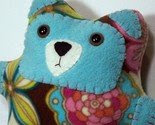At one time dry goods such as flour, rice and chicken feed were sold in sturdy, tightly woven cotton sacks. Frugal consumers often reused the sacks for storage and carrying goods. It was also popular to make linens and clothing from the bag's of fabric. Some producers of cotton sacks even printed them with decorative patterns.
Towels cut from flour sack material are the most absorbent towels I have found. They feel so good in your hands while drying dishes. Homemakers have enjoyed using flour sack towels for many years and they may be used for all kinds of household tasks. Great for drying dishes, polishing glassware and silver, to straining foods and covering rising dough. They do not leave scratches or smears on fine glassware, eyeglasses, windows, computer monitors or t.v. screens.
I highly recommend the flour sack towel for everyday uses. You'll find endless uses for this extra soft, absorbent and lint free towel.
Thursday, February 26, 2009
Monday, February 23, 2009
Hucking tea towels
Hucking towels are made of 100% cotton with a heavy, sturdy, flat, but not thick weave. These towels hold up well and soften with laundering and use. I'm sure you would agree, that hucking tea towels will provide a charming vintage feel to the kitchen.
Labels:
hucking tea towel,
hucking towel,
redwork,
vintage
Sunday, February 22, 2009
Linen tea towels

When most people think of tea towels, the first thing that probably comes to mind is linen tea towels.
Linen is the world's oldest known textile and has been used for centuries. Linen is considered all yarns spun and fabrics woven from flax fiber.
Linen is a textile made from fibers of the flax plant. Top quality flax is primarily grown in Western Europe (Ireland, Italy and Belgium). There are two varieties of flax fibers. Shorter tow fibers used for coarser fabrics, and longer line fibers used for finer fabrics. Linen is the strongest of the vegetable fibers, 2-3 times stronger then cotton. It is smooth, making the finished fabric lint free, and gets softer the more it is washed. Linen has a crisp and textured feel to it. If you notice any small knots that occur randomly, they are actually defects associated with low quality. The finest linen has very consistent threads.
The exclusivity of linen stems from the fact that it is difficult, labor intensive and time consuming to produce. Flax is difficult to weave because of it's lack of elasticity, and therefor is more expensive to manufacture than cotton.
There are some textiles produced in a linen-weave texture made of non-flax fibers such as cotton and hemp. They may be improperly referred to as "linen".
Linen is hypo-allergenic and one of the most environmentally friendly fibers you'll find. The fabric will last for years. The more linen is washed, the more beautiful it becomes.
Linen should not be dried too much in the dryer. It is much easier to iron when damp. Linen wrinkles very easily, but that is often part of the fabrics particular charm
Linen textiles add luxury to a home. You will find products such as bed linens, pillowcases, curtains, tea towels and clothing made of linen fabric.
Thursday, February 19, 2009
Purpose of Tea Towels

It was during the Industrial Revolution that mass production of the tea towels started. During the late 18th Century, England households used a special linen drying cloth to dry precious and expensive china, crystal and dinnerware.
The purpose of the tea towel is to absorb water, so it must be soft and absorbent. Tea towels are mostly made from cotton, linen and terrycloth.
Many places we travel to have tea towels on sale as a souvenir of a landmark or historic event. Some of us like to collect birds, cats, flowers, teapots or even Elvis Presley items. Tea towels can fill this need.
We enjoy the tradition of decorating for the holidays. We acknowledge the coming and goings of changing seasons. Personally, I get a special feeling when I use embellished products in my home for daily rituals. The same goes for specially designed clothing and accessories. Using your tea towel collection is a practical way to decorate your home.
Labels:
tea towel uses,
tea towels,
tea towels histoy
Wednesday, February 18, 2009
Tea Towel Research Opening Statement

Tea towels are drying towels that are used after hand washing dishes. They are perfect for cleaning fine glassware and silver, since they tend not to leave spots or lint fibers behind.
Tea towels have a rich history and are highly collectible items that can be passed on from generation to generation. Tea towels will enhance any kitchen decor, make a thoughtful gift, or can be added to your daughters trousseau.
Tea Towels

Tea towels are drying towels that are used after hand washing dishes. They are perfect for cleaning fine glassware and silver, since they tend not to leave spots or lint fibers behind.
Tea towels have a rich history and are highly collectible items that can be passed on from generation to generation. Tea towels will enhance any kitchen decor, make a thoughtful gift, or can be added to your daughters trousseau.
Monday, February 16, 2009
Welcome to Tea Towel Cottage
This blog contains information about useful textiles, blissful items, tips for new entrepreneurs and internetpreneurs, pets and any other topics that bring joy to me when sharing. I would like to encourage you to implement bliss and your passions into your life.
I hope you find the contents here to be of light reading, informational, useful and at times amusing. Make yourself something to eat or drink and lets spend a brief time checking out the internet.
I hope you find the contents here to be of light reading, informational, useful and at times amusing. Make yourself something to eat or drink and lets spend a brief time checking out the internet.
Labels:
blissful items,
entrepreneurs,
internetpreneurs,
light reading,
New Horizons,
passions,
pets,
textiles
Subscribe to:
Comments (Atom)




